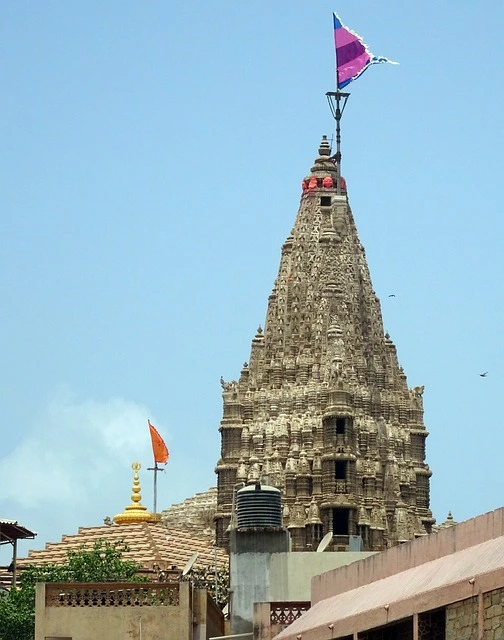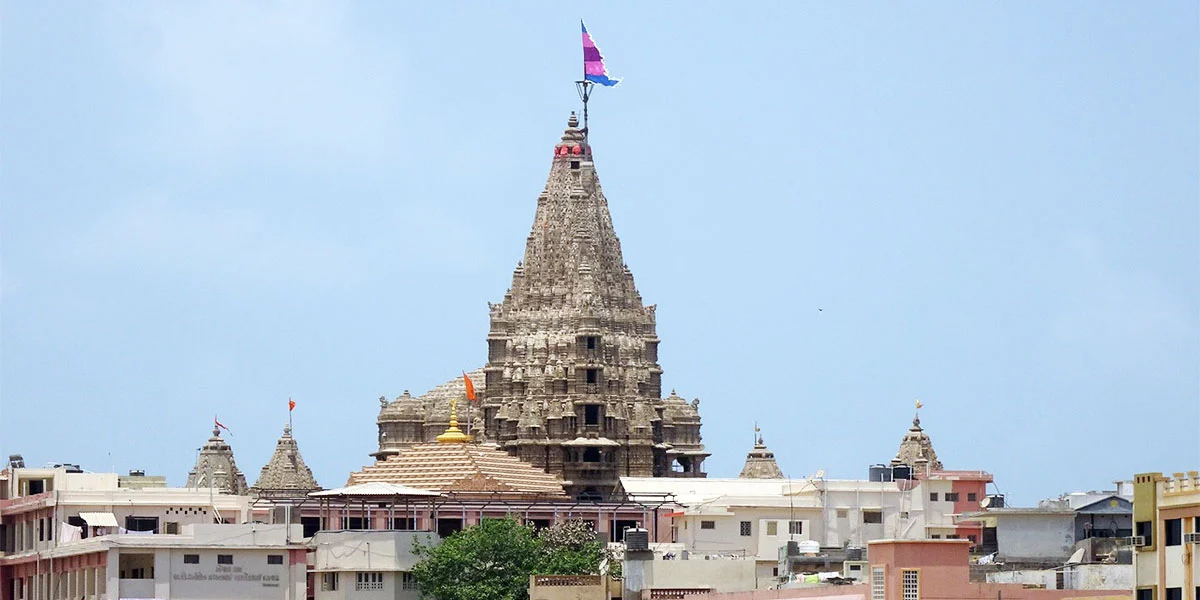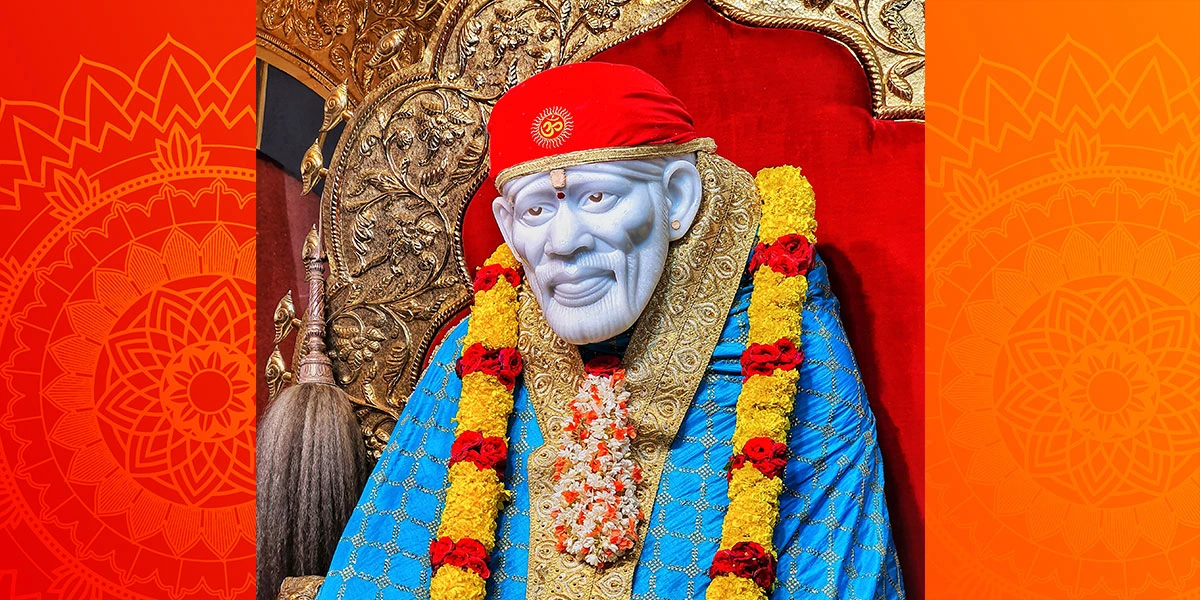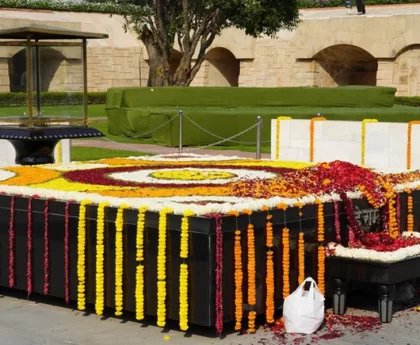Dwarikadish Temple, also known as the Dwarkadhish Temple, is a prominent Hindu temple dedicated to Lord Krishna, located in the historic city of Dwarka in the state of Gujarat, India. The temple is one of the most revered and significant pilgrimage sites for devotees of Lord Krishna and Hinduism as a whole.
History of Dwarikadish Temple
Here is an overview of the history of the Dwarikadish Temple:
Ancient Mythology and Legend:
The history of the Dwarikadish Temple is closely associated with the ancient city of Dwarka, believed to be the legendary kingdom of Lord Krishna. According to Hindu mythology and ancient texts like the Mahabharata and Puranas, Dwarka was the capital of Lord Krishna’s kingdom, known as Dwaraka Kingdom.
It is believed that Lord Krishna settled in Dwarka after leaving Mathura. The city of Dwarka was said to be a majestic and prosperous kingdom. Lord Krishna’s presence and his divine acts attracted devotees and followers.
Construction of the Temple:
The exact date of the construction of the Dwarikadish Temple is not definitively documented, but historical accounts suggest that the temple has ancient origins. It is believed that the original temple was built several centuries ago.
The current temple complex is attributed to various rulers and dynasties that ruled the region over the centuries. It underwent renovations and additions during different periods to enhance its architectural and spiritual significance.
Architectural Style:
The Dwarikadish Temple showcases exquisite architectural elements that blend ancient and intricate design styles. The temple is built in the Chalukya style of architecture, with elements of temple design characteristic of the region.
The main shrine of the temple houses the deity of Lord Krishna in his form as the king of Dwarka. The temple features a five-story spire (shikhara) adorned with intricate carvings and sculptures. The structure is adorned with sculptures of gods, goddesses, and celestial beings, depicting various scenes from Hindu mythology.
Religious Significance:
The Dwarikadish Temple holds immense religious significance for devotees of Lord Krishna. It is considered one of the holiest pilgrimage sites for Hindus and is an integral part of the Char Dham Yatra, which includes three other sacred sites: Badrinath, Jagannath Puri, and Rameswaram.
The temple is a place of devotion, worship, and spiritual significance. Pilgrims visit the temple to seek blessings, offer prayers, and participate in various religious rituals and festivals.
Preservation and Restoration:
Throughout history, the Dwarikadish Temple has undergone several renovations and restorations to maintain its grandeur and sanctity. The temple has been rebuilt and refurbished by different rulers and religious patrons to ensure that it remains a symbol of devotion and cultural heritage.
Today, the Dwarikadish Temple continues to attract thousands of devotees and visitors who come to experience its spiritual aura, architectural beauty, and historical legacy. It stands as a testament to the reverence and devotion associated with Lord Krishna and his presence in the ancient city of Dwarka.
Location of Dwarikadish Temple
The Dwarikadish Temple, dedicated to Lord Krishna, is located in the city of Dwarka in the state of Gujarat, India. Dwarka is situated on the western coast of India, overlooking the Arabian Sea.
The exact address of the Dwarikadish Temple is: Dwarikadish Temple, Dwarka, Gujarat, India
The temple is a significant pilgrimage site for Hindus and is associated with the legends and divine activities of Lord Krishna. It attracts devotees and tourists from all over the country and beyond who come to seek blessings and experience the spiritual and cultural significance of this sacred place.

Entry Fees of Dwarikadish Temple
The Dwarikadish Temple in Dwarka, Gujarat, does not typically charge an entry fee for devotees or visitors. Hindu temples in India generally do not have an entry fee for regular darshan (viewing of the deity) and participation in religious activities.
However, please note that practices and policies can change over time, and it’s always a good idea to verify the current situation before planning your visit. You can check with local authorities, the temple administration, or reliable sources online to confirm whether there have been any updates regarding entry fees or any other guidelines for visiting the Dwarikadish Temple.
Keep in mind that while there might not be an entry fee for the temple itself, some temples offer paid services or arrangements for specific types of darshan or ceremonies. It’s a good practice to respect the temple’s rules and regulations and contribute to its upkeep through voluntary donations or offerings, if you wish.
Timings of the Dwarikadish Temple
The Dwarikadish Temple in Dwarka, Gujarat, generally follows a schedule of opening and closing timings for devotees. However, these timings can vary on special occasions, festivals, and during certain rituals. It’s important to note that the temple timings can change, so it’s recommended to verify the current timings before planning your visit. You can do so by checking with the temple administration, their official website, or local sources.
As a general guideline, the Dwarikadish Temple’s timings might be as follows:
Morning:
– The temple usually opens in the early morning hours, often before sunrise, for Mangala Aarti and darshan.
– Mangala Aarti is a morning ritual of offering prayers and light to the deity.
Daytime:
– The temple remains open for devotees to have darshan and offer prayers throughout the day.
– Special pujas, aartis, and rituals may be conducted at various times during the daytime.
Evening:
– The temple usually closes for a brief period in the afternoon (around midday) for rest and preparations for the evening aarti.
– Evening Aarti (Sandhya Aarti) is performed, and devotees gather to offer prayers.
Please note that these timings are provided as a general guideline, and actual timings might vary. It’s advisable to check the accurate and up-to-date timings before planning your visit to the Dwarikadish Temple. Additionally, during festivals or special occasions, the temple timings and rituals may be different, so it’s a good idea to plan your visit accordingly.
Official Website:- https://www.dwarkadhish.org/
How to Reach Dwarikadish Temple
The Dwarikadish Temple is located in the city of Dwarka in the state of Gujarat, India. It is a significant pilgrimage site for Hindus and is easily accessible by various modes of transportation.
Here’s how you can reach the Dwarikadish Temple:
By Air:
The nearest major airport to Dwarka is the Jamnagar Airport (approximately 137 kilometers away). From the airport, you can hire a taxi or use other local transportation options to reach Dwarka.
By Train:
Dwarka has its own railway station called “Dwarka Railway Station.” It is well-connected to major cities in Gujarat and other parts of India. Several trains run to and from Dwarka, making it a convenient option for travelers.
By Road:
Dwarka is connected by well-maintained roads to various cities in Gujarat and neighboring states. You can use buses, taxis, or private vehicles to reach Dwarka by road. The city is approximately 450 kilometers from Ahmedabad and around 220 kilometers from Jamnagar.
Local Transportation:
Once you arrive in Dwarka, you can use local transportation options such as auto-rickshaws and cycle-rickshaws to get around the city and reach the Dwarikadish Temple. The temple is located in the heart of Dwarka and is easily accessible within the city.
Important Tips:
- It’s a good idea to check the current transportation options, schedules, and timings before planning your journey, especially if you’re traveling long distances.
- Consider making travel arrangements in advance, especially during peak pilgrimage seasons and festivals, to ensure a smooth and comfortable trip.
- While planning your visit, also check the opening and closing timings of the Dwarikadish Temple to make the most of your pilgrimage experience.
Keep in mind that my information is based on the knowledge available up to September 2021, and there may have been developments or changes since then. It’s always a good practice to verify travel details from reliable sources before embarking on your journey.
If you don’t like this article/post please share your feedback.




